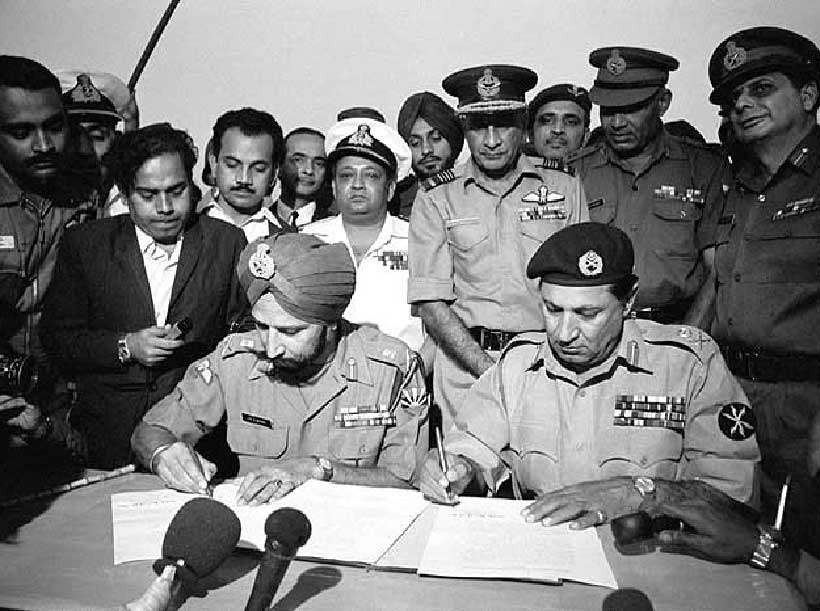The creation of Bangladesh is one of the most sensitive and tragic chapters in the history of Pakistan. On Dec 16, 1971, Pakistani troops laid down their arms and surrendered for secession of East Pakistan. It is considered the darkest day in our history. The grievances of Dhaka were political one: it should have been handled with a political approach. Thousands of innocent civilians lost their lives in this tragedy.
On Mar 25, 1969, Gen Ayub resigned and handed over govt to General Yahya Khan. After that, first democratic election in history of Pakistan took place in Dec 1970, in which Awami League won a majority. Awami League did not get a single seat from West Pakistan and PPP met the same fate in the East wing.
Awami League had full rights to form a govt and rule over Pakistan. However, the leadership of West Pakistan denied the transfer of power to Awami League. Despite political issues, the external factor still played a major factor in fall of Dhaka.
Indian Army trained Mukti Bahini with best military skills in six months to foment insurgency in East Pakistan. Indian Army along with Mukti Bahini started invading main check posts from 30th Nov and till 3rd Dec 1971, they encircled Eastern wing completely. India had built hundreds of camps in West Bengal and trained armed Bengali youths from East Pakistan to form Mukti Bahini. By mid-Nov 1971, border skirmishes were rapidly turning into bloody attacks on Pakistani troops. Eventually, on Dec 3, 1971, war with India was declared. On Dec 4-5, Indian planes, MIG-21s and SU-7s, attacked Dhaka Airport. Indian artillery was used extensively in support of rebel operations in East Pakistan to disintegrate Pakistan in 1971.
The war on ground was being fought in Jessore, Khulna, Natore, Kushtia, Rangpur, Dinajpur, Sylhet. After getting surrounded by Indian forces on Dec 16, 1971, Gen Niazi signed Instrument of Surrender and handed over his pistol to Gen Arora Singh. Even with a common ideology and a joint struggle for freedom, physical separation of East and West Pakistan by 1000 miles exerted tremendous pressure on two sides to go their separate ways. The binding force between people of East and West Pakistan was Islam; otherwise, there were huge differences in language, culture, and traditions.
One of the factors was that pace of economic development in East Pakistan was much slower than in West. Pakistan’s main foreign exchange earner was jute known world over as golden fiber followed by tea. Both were mainly grown in East Pakistan and Eastern wing felt that they are not getting their justified share. Their other major grievance was lack of proper representation of Bengalis in military and bureaucracy despite the fact they were in majority. Shifting of capital from Karachi to Islamabad by Ayub Khan deepened a sense of deprivation and ignited a strong nationalism among Bengali population.
A few wrong myths and concocted facts which need clarification include that it is impossible to carry out rapes of two hundred thousand women in a span of two years. For almost 30 years, not a word was printed in Western press about rapes committed by Indian troops and rebel militia. The number of Pakistani soldiers was exaggerated. The actual number was 34,000, with 11,000 police, rangers, scouts, and militia. This made the total number of combatants 45,000.
It is not a culture of Pak Army to carry out mass killings, which are evident from the operations in War on terror. The allegation of the Genocide of three Million Bengalis is fake propaganda by India to defame Pakistan.
Operation searchlight is also a drama posed by Awami League and India as Shaikh Mujib ordered his hooligans to destroy powerhouses, bridges, and communication systems and to loot and plunder ration depots that compelled Pak army to launch the military operation and restore peace. Urdu, being lingua franca, was a unifying factor for Muslims of sub-continent that’s why it was made national language. Indian intervention was not on humanitarian grounds but it was a vicious, planned attack on Pakistan’s territory. These plans were made with consent of Awami League in an infamous meeting known as Agartala Conspiracy.
Another propaganda, that Bengalis negated the concept of Two Nation Theory was also wrong as after seceding from Pakistan, Bangladesh had to merge with India as was in pre-partition era, which it did not. Even after succeeding from Pakistan, Muslims in Bangladesh don’t consider themselves similar to Hindus. Nevertheless, Pak Army fought valiantly in tough conditions, Logistical problems faced by West Pakistan in 1971 war need due consideration. Pakistani troops gave heroic fight despite enemy’s superiority in both numbers and firepower.
No doubt, we learned a lesson from tragedy of East Pakistan when we resolved issue of provincial autonomy in 1973 Constitution and later after 2008 elections, consolidated federation further by 18th Amendment. Mistakes were committed by both sides that led to bloodshed and creation of Bangladesh. Great nations learn from their past mistakes and make their way forward. On 16 of Dec, as a nation, we have to choose that if we want to live with unity and dignity we have to strengthen our bonds by sharing justice, love, and respect. This day should be remembered to pay homage to the patriots who gave their lives for Pakistan.


